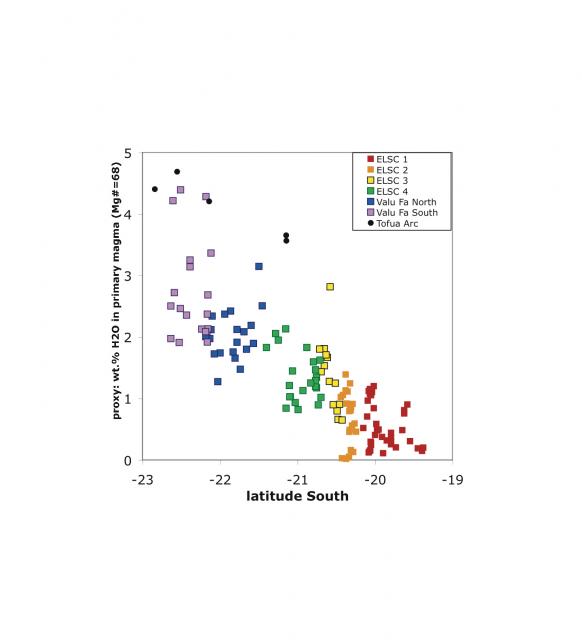Michael
Michael, P.J.1 and C.H. Langmuir2, S. Escrig2, A. Bézos3, P. Asimow4, A Matzen4
1Dept. of Geosciences, The University of Tulsa
2Dept of Earth and Planetary Sciences, Harvard University
3Laboratoire de Planétologie et Géodynamique de Nantes, University of Nantes
4Division of Geological and Planetary Sciences, Caltech
The high H2O concentration of the Lau mantle source and magmas is perhaps the most influential characteristic of the Lau ISS. High H2O concentrations influences mantle flow, mantle melting, magma ascent, crustal porosity and magma degassing, including contributions to hydrothermal systems and the life they support.
We have determined H2O for magmas from Eastern Lau Spreading Center (ELSC) from 19°20’ to 20°30’S. Because of degassing, it not possible to determine H2O contents directly from pillow rim glasses south of 20°30’: they are too H2O-rich. We have combined melt inclusion data for southern Valu Fa Ridge (VFR; 22°30’) with our data from the ELSC to look for consistent relationships between H2O and trace elements, so that we can define a proxy for H2O content south of 20°30’. The K2O content of glasses seems to provide the most consistent proxy for calculating magmatic H2O cotents: better than Ba, Cl and Yb. Proxy H2O contents can be used to calculate the H2O content of the mantle supplying ELSC-VFR, as done by Bézos et al., (2009) for the northernmost segment of ELSC.
The calculated H2O contents of primary magmas can be used to estimate depths and extents of vesicle formation if the extent of crystallization as a function of depth is known or assumed. Because H2O degasses at shallow levels compared to CO2, it has a much greater ability to create porosity in the crust if its vesicles can be frozen in the rocks. Our preliminary calculations suggest that some vesiculation takes place in ascending magmas beneath the AMC for the Valu Fa Ridge. Magmas ascending from the AMC will also form vesicles in the upper crust. In this case, magmas ascending from a deeper AMC should produce more gas for vesiculation than magmas ascending from a shallow AMC. Magmas ascending beneath the northern ELSC contain lower H2O contents, so vesiculation should be a much shallower phenomenon and similar to mid-ocean ridges.
It is relatively straightforward to calculate the amount Sulfur lost from the magma based on the S contents expected at a given FeO content. Although the S in the magma of ELSC-VFR occurs almost completely as S2-, even in the southern end of VFR, the speciation of S in the exsolved gas phase is more complicated. It is some combination of SO2 and H2S.

